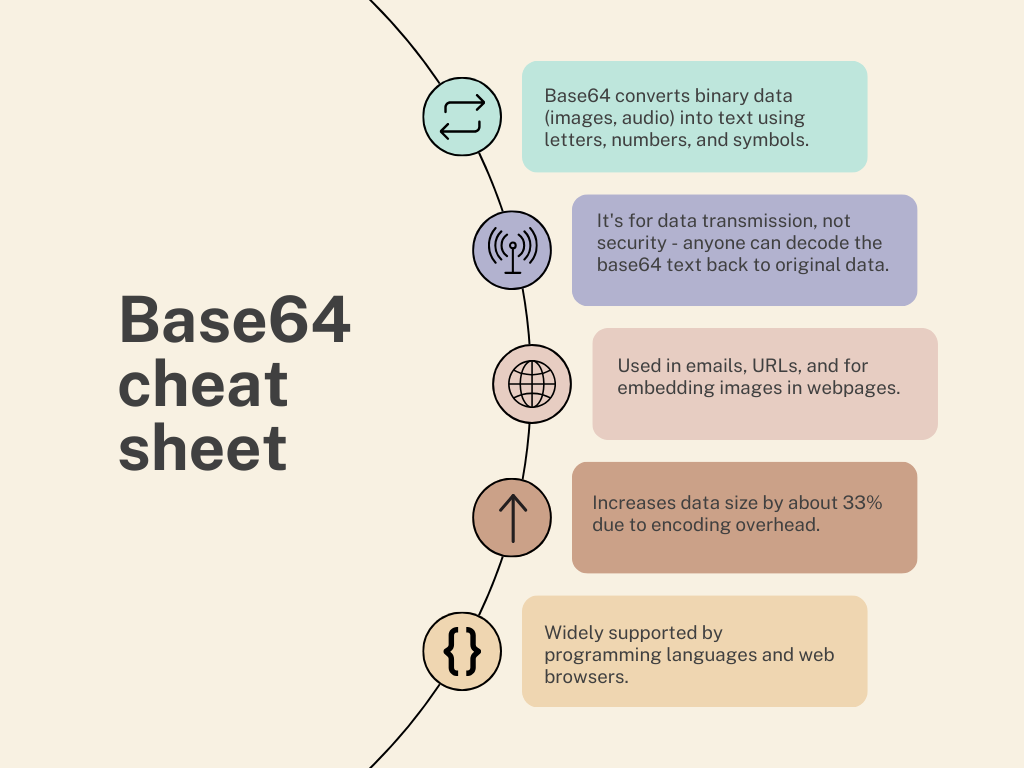The efficient and dependable processing of data is critical in current data management and transmission systems. Base64 encoding is a popular approach for converting binary data into textual representation, making it more manageable and storable. PostgreSQL, on the other hand, is a powerful open-source relational database management system that is used in a wide range of applications. In this tutorial, we will go deep into the realm of PostgreSQL Base64 encoding and decoding.
What is Base64?
Base64 is a way of encoding binary data into ASCII characters to improve data transmission and storage, which is critical in situations when binary data cannot be saved or transmitted. This encoding ensures that the data remains unchanged during transit. Base64 is widely used in a wide range of applications, including email and the storage of complex data in XML or JSON.
The binary data is converted into a series of 8-bit bytes, which are then represented as 64 distinct printable characters in Base64 encoding, thus the name ‘Base64’. The characters chosen for the 64 required for the base can vary between implementations. The main technique is to choose 64 characters from a subset that is shared by most encodings and is also printable. Because of this combination, it is unlikely that the data will be altered in transit via services such as email, which were previously not 8-bit clean. The Base64 index table contains A-Z, a-z, 0-9, +, and / for the first 62 values. At the end, the ‘+’ and ‘/’ characters are used to pad the encoded value.

What is PostgreSQL?
PostgreSQL, often referred to as “Postgres”, is a powerful and widely-used open-source relational database management system (RDBMS) that has become a cornerstone of modern database management. Developed and maintained by a dedicated global community, PostgreSQL offers a rich set of features and capabilities that cater to a diverse range of data management needs.
Renowned for its resilience, versatility, and extensibility, PostgreSQL is a popular choice for developers and organizations working on projects of all sizes, from small-scale applications to large, enterprise-level databases. PostgreSQL’s robust architecture and strict adherence to SQL standards ensure high performance, reliability, and data integrity, making it an ideal choice for mission-critical applications.
With its support for a wide range of data types, indexing methods, and built-in replication capabilities, PostgreSQL empowers developers to build sophisticated, scalable, and secure database solutions. Furthermore, its extensive ecosystem of tools, libraries, and extensions enables seamless integration with various programming languages, frameworks, and third-party applications, making PostgreSQL an indispensable tool for modern data management.
Key Characteristics of PostgreSQL:
- Open-Source: PostgreSQL is open-source software, which means it is freely available for anyone to use, modify, and distribute. This open nature has led to a vibrant and active community of developers and users.
- Relational Database: PostgreSQL is a relational database system, which means it stores data in structured tables with predefined schemas. This makes it suitable for applications where data integrity and consistency are essential.
- ACID Compliant: PostgreSQL follows the principles of ACID (Atomicity, Consistency, Isolation, Durability) to ensure reliable and secure data transactions.
- Extensible: One of PostgreSQL’s standout features is its extensibility. Developers can create custom functions, operators, data types, and even entire extensions to enhance the database’s capabilities.
- Advanced Data Types: PostgreSQL supports a wide range of data types, including native support for JSON, arrays, and hstore (a key-value store). This versatility allows developers to work with complex data structures efficiently.
- Concurrency Control: PostgreSQL employs advanced concurrency control mechanisms, such as Multi-Version Concurrency Control (MVCC), to handle multiple transactions simultaneously without compromising data integrity.
- Scalability: PostgreSQL can scale horizontally by distributing data across multiple servers or vertically by adding more resources to a single server. This scalability makes it suitable for both small-scale projects and large, high-traffic applications.
Use Cases for PostgreSQL:
- Web Applications: Many web-based applications and websites use PostgreSQL as their backend database because of its performance, security, and support for geospatial data.
- Data Warehousing: PostgreSQL’s support for advanced analytics and OLAP (Online Analytical Processing) makes it suitable for data warehousing solutions.
- Geographic Information Systems (GIS): PostgreSQL’s PostGIS extension adds geospatial capabilities, making it ideal for GIS applications.
- Content Management Systems (CMS): Numerous content management systems, including some popular ones like Drupal and TYPO3, use PostgreSQL as their database backend.
- Business Applications: PostgreSQL is used in various business applications, including customer relationship management (CRM) systems, financial applications, and inventory management systems.
Base64 Encoding in PostgreSQL
When working with PostgreSQL, developers often need to handle binary data in various formats. Fortunately, PostgreSQL offers built-in methods for encoding and decoding data in Base64 format, providing a versatile approach to managing binary data.
The encode() and decode() functions in PostgreSQL enable developers to easily convert binary data to Base64 format and vice versa, ensuring seamless storage and retrieval of data.
To encode binary data into Base64 format in PostgreSQL, you can use the encode function. Here’s an example of how to encode binary data:
-- Encode binary data into Base64 SELECT encode(bytea_column, 'base64') AS base64_encoded_data FROM your_table;
In this SQL query, bytea_column is the binary data column that you want to encode. The encoding format is specified as ‘base64’, which in this case is Base64. The output column is renamed as base64_encoded_data for clarity.
Base64 Decoding in PostgreSQL
In PostgreSQL, you may need to convert Base64-encoded data back to its original binary form for further processing or storage.
The decode() function provides a simple and efficient way to accomplish this task. Here’s a look at how to use the decode() function in PostgreSQL to convert Base64-encoded data back to its original binary form:
-- Decode Base64 data into binary SELECT decode(base64_encoded_data, 'base64') AS decoded_data FROM your_table;
In this query, base64_encoded_data is the Base64-encoded data column. The decoding format is specified as ‘base64’. The output column is renamed as decoded_data.







